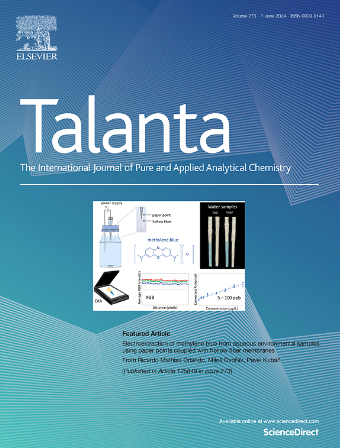Comprehensive analysis strategy of quality for traditional Chinese medicine compound based on fingerprint technology and quantitative prediction of spectra
IF 5.6
1区 化学
Q1 CHEMISTRY, ANALYTICAL
引用次数: 0
Abstract
Traditional Chinese medicine compound (TCMC) comes from a wide range of sources, and the complexity of chemical composition leads to differences in quality. Improving quality evaluation standards is the focus as well as the difficulty in its development and application. The traditional fingerprint analysis method has certain limitations for the quality evaluation of TCMC and the judgment of superior and inferior products. Therefore, how to optimize the similarity evaluation method of fingerprint and mine the sample data on the basis of fingerprint to fully reflect the essential differences in the quality of TCMC is the focus of this paper. In this paper, the quantified fingerprint method of integral efficiency (IEQFM) combined with dual control of peak area and retention time was proposed to optimize the similarity evaluation method. The HPLC, GC and UV fingerprints of 35 batches of compound liquorice tablets (CLTs) were evaluated as an example. The offline-wavelength switching method was explored to simplify the multi-wavelength data processing method. Secondly, the 11 components in the CLTs were accurately quantitatively analyzed by the single-linear assay multi-markers method and the standard curve method. Orthogonal partial least squares-discriminant analysis (OPLS-DA) analysis was used to find the signature components affecting the quality difference. For UV spectra, quantum fingerprints were obtained by preprocessing using characteristic concatenation method and quantitatively predicted using the partial least squares regression (PLSR) model (p > 0.7). Finally, the three fingerprint profiles were fused and evaluated after assigning weights to the different evaluation methods using the criteria importance through intercriteria correlation (CRITIC) method. In order to adapt to the evolving TCMC, method optimization is of great significance to improve the quality evaluation criteria. This study provides an exploratory method for the quality analysis of TCMC.

求助全文
约1分钟内获得全文
求助全文
来源期刊

Talanta
化学-分析化学
CiteScore
12.30
自引率
4.90%
发文量
861
审稿时长
29 days
期刊介绍:
Talanta provides a forum for the publication of original research papers, short communications, and critical reviews in all branches of pure and applied analytical chemistry. Papers are evaluated based on established guidelines, including the fundamental nature of the study, scientific novelty, substantial improvement or advantage over existing technology or methods, and demonstrated analytical applicability. Original research papers on fundamental studies, and on novel sensor and instrumentation developments, are encouraged. Novel or improved applications in areas such as clinical and biological chemistry, environmental analysis, geochemistry, materials science and engineering, and analytical platforms for omics development are welcome.
Analytical performance of methods should be determined, including interference and matrix effects, and methods should be validated by comparison with a standard method, or analysis of a certified reference material. Simple spiking recoveries may not be sufficient. The developed method should especially comprise information on selectivity, sensitivity, detection limits, accuracy, and reliability. However, applying official validation or robustness studies to a routine method or technique does not necessarily constitute novelty. Proper statistical treatment of the data should be provided. Relevant literature should be cited, including related publications by the authors, and authors should discuss how their proposed methodology compares with previously reported methods.
 求助内容:
求助内容: 应助结果提醒方式:
应助结果提醒方式:


